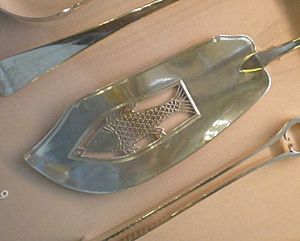Benton Seymour Rabinovitch facts for kids
Quick facts for kids
Seymour Rabinovitch
|
|
|---|---|
 |
|
| Born |
Benton Seymour Rabinovitch
19 February 1919 |
| Died | 2 August 2014 (aged 95) |
| Alma mater | McGill University |
| Known for | Detection methods for chemical warfare agents Understanding rates of gas phase chemical reactions Silversmithing |
| Awards | Polanyi Medal (1984) Peter Debye Award (1984) Fellow of the Royal Society (1987) |
| Scientific career | |
| Fields | Chemistry |
| Institutions | University of Washington |
| Thesis | Studies in chemical kinetics (academic research) and the detection of vesicants (war research) (1942) |
Seymour Rabinovitch (born February 19, 1919 – died August 2, 2014) was a smart chemistry professor at the University of Washington in Seattle. He studied how energy moves between tiny particles (molecules) during chemical reactions in gases.
Besides his science work, Rabinovitch was also an editor for important science magazines like the Annual Review of Physical Chemistry and the Journal of the American Chemical Society.
After he retired from teaching, he became a silversmith. This means he worked with silver, learning about its chemistry. He also collected and wrote books about silver objects. In 2000, he became an honorary member of a special group in London called the Worshipful Company of Goldsmiths. A part of his amazing collection of silver tools was given to the Victoria and Albert Museum in 2005.
Contents
Seymour Rabinovitch's Life and Work
Benton Seymour Rabinovitch was born in Montreal, Canada. His parents were immigrants. Even though times were tough during the Great Depression, he worked hard. He earned his first degree from McGill University in 1939. He then got his PhD in 1942. His PhD research looked at how chemical reactions happen and how to find harmful gases used in war.
Helping During World War II
During World War II, Rabinovitch joined the Canadian government's Chemical Warfare Laboratory. He used his PhD research to create a simple way to find mustard gas. This gas was a dangerous chemical warfare agent. He made special cloth patches that changed color if mustard gas was nearby. This helped warn soldiers.
After D-Day, Rabinovitch and his team went to France. Their job was to check German factories and battlefields. They looked for proof that Germany had broken rules about weapons, which are part of the Geneva Convention.
Becoming a Professor
After the war, Rabinovitch taught for a short time in England. Then, he went to Harvard University in the United States to do more research in physical chemistry.
In 1948, he became a chemistry professor at the University of Washington in Seattle. He became a full professor in 1957.
Discoveries in Chemistry
For over 40 years, Rabinovitch was a leader in chemical dynamics. This field studies how chemical reactions happen. He and his students found new ways to measure how well energy moves between molecules. They looked at molecules bumping into each other in gases. They also studied molecules hitting solid surfaces.
He showed how the energy inside molecules affects how fast chemical reactions happen. He was the first to prove important ideas like the RRKM theory. This theory helps scientists understand how molecules break apart or change. His experiments and math skills helped us understand chemical kinetics (how fast reactions go) and molecular dynamics (how molecules move).
From 1977 to 1985, Rabinovitch was the main editor for the Annual Review of Physical Chemistry. He also edited the Journal of the American Chemical Society. He kept doing science even after he officially retired in 1986.
His Love for Silversmithing
After retiring from the University of Washington in 1986, Rabinovitch became a silversmith. He loved learning about the chemistry of silver. He was especially interested in old silver tools used for serving food. He collected many of these.
He wrote important books about the history and chemistry of silver. These included Antique Silver Servers for the Dining Table (1991) and Contemporary Silver (2000).
He also wrote for magazines like Silver Magazine and Metalsmith. He was a member of the Silver Society in London. In 2000, he became an honorary member of the Worshipful Company of Goldsmiths.
Rabinovitch also helped new silversmith artists. He asked artists in the U.S. and Britain to create over 60 new silver serving pieces. His collection of silver servers was shown in many exhibitions. The first was in London in 1995. Later, his collection traveled to museums in Canada, Scotland, and the U.S. In 2005, his entire collection was given to London's Victoria and Albert Museum. It became a permanent part of their collection.
Personal Life
Seymour Rabinovitch married Marilyn Werby in 1949. They had four children together. Marilyn passed away in 1974. In 1980, Rabinovitch married Flora Reitman.
He even wrote a children's book called Higgledy piggledy: a tale of four little pigs (2013). He based it on stories he used to tell his own children.
Rabinovitch was also a philanthropist. This means he gave money to help others. He set up an award at the University of Washington. This award helped the Metals Program buy art pieces made by students. This fund, named after his first wife, helped students from 1993 to 2008.
Seymour Rabinovitch passed away on August 2, 2014, in Seattle, Washington.
Awards and Honours
- 1968: Fellow of the American Physical Society (APS)
- 1979: Fellow of the American Academy of Arts and Sciences (AAAS)
- 1984: Peter Debye Award, from the American Chemical Society (ACS)
- 1984: Polanyi Medal, from the Royal Society
- 1987: Fellow of the Royal Society
- 1991: Honorary Doctorate of Science, from Technion – Israel Institute of Technology


